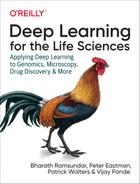Preface
In recent years, life science and data science have converged. Advances in robotics and automation have enabled chemists and biologists to generate enormous amounts of data. Scientists today are capable of generating more data in a day than their predecessors 20 years ago could have generated in an entire career. This ability to rapidly generate data has also created a number of new scientific challenges. We are no longer in an era where data can be processed by loading it into a spreadsheet and making a couple of graphs. In order to distill scientific knowledge from these datasets, we must be able to identify and extract nonobvious relationships.
One technique that has emerged over the last few years as a powerful tool for identifying patterns and relationships in data is deep learning, a class of algorithms that have revolutionized approaches to problems such as image analysis, language translation, and speech recognition. Deep learning algorithms excel at identifying and exploiting patterns in large datasets. For these reasons, deep learning has broad applications across life science disciplines. This book provides an overview of how deep learning has been applied in a number of areas including genetics, drug discovery, and medical diagnosis. Many of the examples we describe are accompanied by code examples that provide a practical introduction to the methods and give the reader a starting point for future research and exploration.
Conventions Used in This Book
The following typographical conventions are used in this book:
- Italic
-
Indicates new terms, URLs, email addresses, filenames, and file extensions.
Constant width-
Used for program listings, as well as within paragraphs to refer to program elements such as variable or function names, databases, data types, environment variables, statements, and keywords.
Constant width bold-
Shows commands or other text that should be typed literally by the user.
Constant width italic-
Shows text that should be replaced with user-supplied values or by values determined by context.
Tip
This element signifies a tip or suggestion.
Note
This element signifies a general note.
Warning
This element indicates a warning or caution.
Using Code Examples
Supplemental material (code examples, exercises, etc.) is available for download at https://github.com/deepchem/DeepLearningLifeSciences.
This book is here to help you get your job done. In general, if example code is offered with this book, you may use it in your programs and documentation. You do not need to contact us for permission unless you’re reproducing a significant portion of the code. For example, writing a program that uses several chunks of code from this book does not require permission. Selling or distributing a CD-ROM of examples from O’Reilly books does require permission. Answering a question by citing this book and quoting example code does not require permission. Incorporating a significant amount of example code from this book into your product’s documentation does require permission.
We appreciate, but do not require, attribution. An attribution usually includes the title, author, publisher, and ISBN. For example: “Deep Learning for the Life Sciences by Bharath Ramsundar, Peter Eastman, Patrick Walters, and Vijay Pande (O’Reilly). Copyright 2019 Bharath Ramsundar, Karl Leswing, Peter Eastman, and Vijay Pande, 978-1-492-03983-9.”
If you feel your use of code examples falls outside fair use or the permission given above, feel free to contact us at [email protected].
O’Reilly Online Learning
Note
For almost 40 years, O’Reilly has provided technology and business training, knowledge, and insight to help companies succeed.
Our unique network of experts and innovators share their knowledge and expertise through books, articles, conferences, and our online learning platform. O’Reilly’s online learning platform gives you on-demand access to live training courses, in-depth learning paths, interactive coding environments, and a vast collection of text and video from O’Reilly and 200+ other publishers. For more information, please visit http://oreilly.com.
How to Contact Us
Please address comments and questions concerning this book to the publisher:
- O’Reilly Media, Inc.
- 1005 Gravenstein Highway North
- Sebastopol, CA 95472
- 800-998-9938 (in the United States or Canada)
- 707-829-0515 (international or local)
- 707-829-0104 (fax)
We have a web page for this book, where we list errata, examples, and any additional information. You can access this page at http://bit.ly/deep-lrng-for-life-science.
To comment or ask technical questions about this book, send email to [email protected].
For more information about our books, courses, conferences, and news, see our website at http://www.oreilly.com.
Find us on Facebook: http://facebook.com/oreilly
Follow us on Twitter: http://twitter.com/oreillymedia
Watch us on YouTube: http://www.youtube.com/oreillymedia
Acknowledgments
We would like to thank Nicole Tache, our editor at O’Reilly, as well as the tech reviewers and beta reviewers for their valuable contributions to the book. In addtion, we would like to thank Karl Leswing and Zhenqin (Michael) Wu for their contributions to the code and Johnny Israeli for valuable advice on the genomics chapter.
Bharath would like to thank his family for their support and encouragement during many long weekends and nights working on this book.
Peter would like to thank his wife for her constant support, as well as the many colleagues from whom he has learned so much about machine learning.
Pat would like to thank his wife Andrea, and his daughters Alee and Maddy, for their love and support. He would also like to acknowledge past and present colleagues at Vertex Pharmaceuticals and Relay Therapeutics, from whom he has learned so much.
Finally, we want to thank the DeepChem open source community for their encouragement and support throughout this project.
